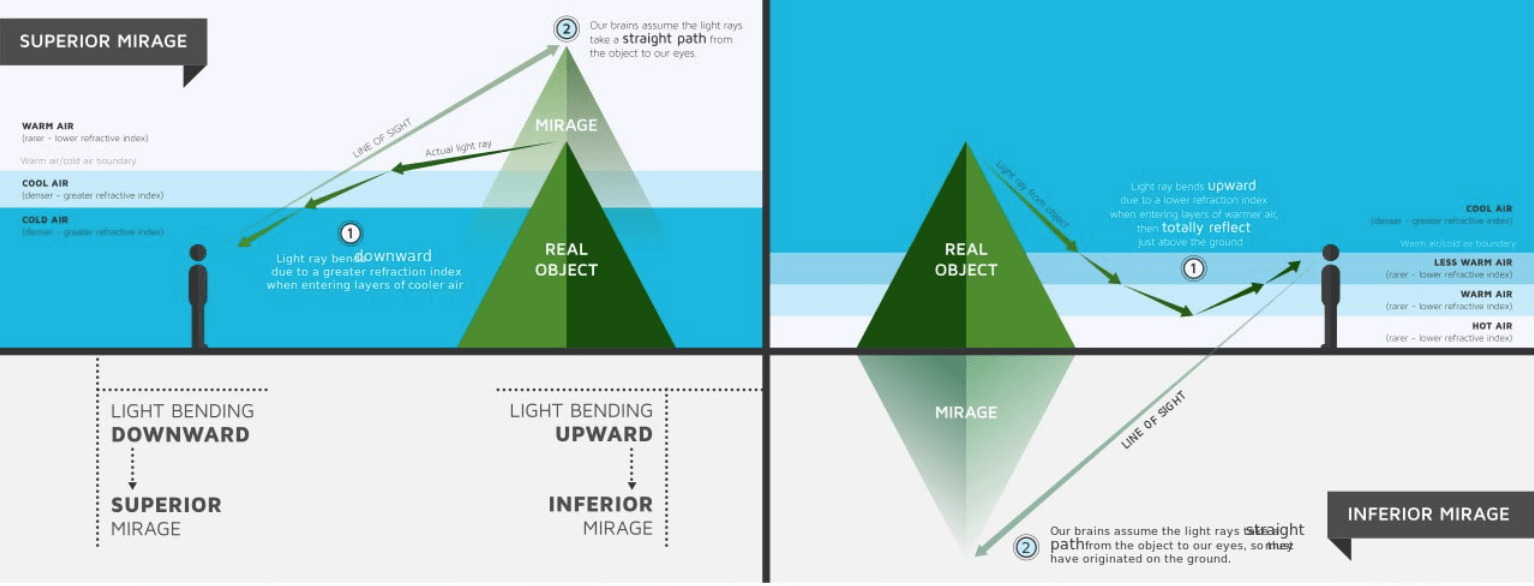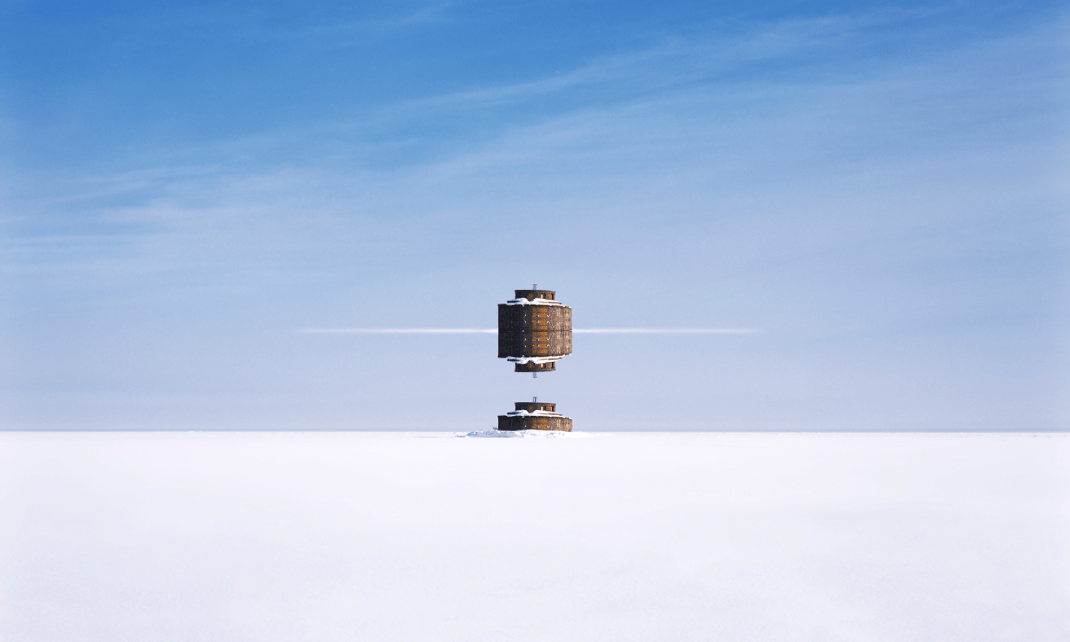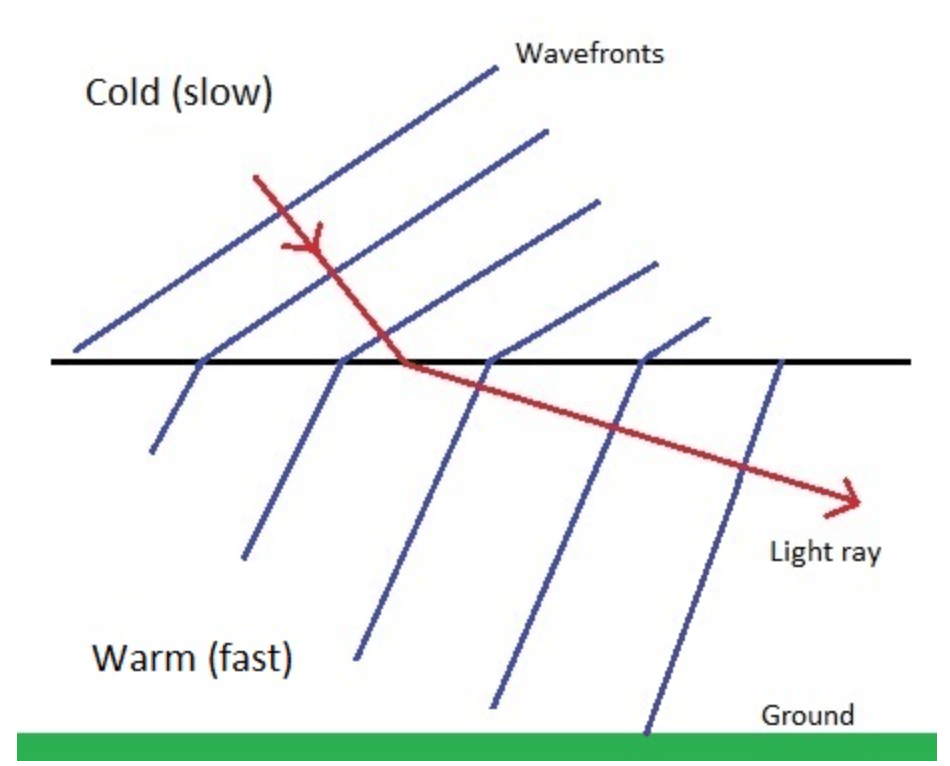Objectives:
- To identify refraction that occurs in the atmosphere naturally
- To understand the reason for this natural refraction
Optical Density
As you will have read in the page on refraction, regarding the critical angle, the amount in which light refracts appears to be dependent on some kind of density;
When a light ray, travelling from a more dense medium to a less dense medium, strikes the boundary between the mediums, one of three things can occur;

- The light can refract through the boundary and change direction – because it is going from a more dense to less dense medium it will refract away from the normal – as shown in the far left image.
- The light reflects off the surface and can remain in the more dense medium – as shown in the far right image.
- At a specific angle between the ray either reflecting or refracting, the light can change direction such that it ends up travelling along the boundary of the two mediums – as shown in the middle image.
In the case of electromagnetic waves, the amount of refraction that occurs (or the speed of the wave) depends on the optical density of that material. The optical density of a medium is not the same as its physical density; the physical density refers to the mass per unit volume, whereas the optical density of a material is determined by its atoms resistance to maintaining the absorbed energy of an electromagnetic wave (in the form of vibrating electrons).
A refractive index value, can be associated with a particular medium, take air as an example, this has a refractive index of
. This value is linked to the optical density of air which is dependent on the concentration of electrons per unit volume. If the the number of electrons in a given volume increases (i.e. due to the physics density of air increasing), the ability for the electrons to absorb the energy of an electromagnetic wave increases and so the speed of the electromagnetic wave decreases which results in more refraction. I.e.
Increased physics density increased concentration of electrons per unit volume
more absorption of EM wave energy
EM waves slows down more
greater refraction.
Or the reverse argument and simplified:
Decreased physics density EM waves slows down by a smaller rate
Smaller refraction.
Refraction for all to see
Have you ever seen a mirage like this?

This image shows what seems like water on a stretch of road, but oil fact this is not the case and it is just a really hot day. Can you use the information providing above regarding optical densities to explain this effect?
The reasoning is below;
All mirages are produces by the refraction of light as it passes between different mediums of different optical densities. In the atmosphere optical density boundaries can be produces by steep thermal gradients; this is where temperature rapidly increase or decrease with height. Light travels more slowly in colder, denser air than it does in warm air. So as light travels and passes from colder air (higher up in the atmosphere) to warmer air (closer to the ground), the wave speeds up and as a result refraction can be observed.
This image shows an example of light passing from colder air to warmer air using wavefronts – for a recap on wavefronts and this type of diagram click here.
The colder air is more dense, the warm air less dense and so the particle and their electrons are more spread out and so the EM wave speeds up. If light speeds up it refracts away from the normal.
On a really hot day with light incident on the ground, the ground heats up the ground heats up and the air that comes into contact with it absorbs some of this energy and in turn heats up too. The resulting strong temperature gradients mean that light rays that would otherwise be headed for the ground are refracted away from the normal (then refracted again the closer it gets to the surface, where the warmer air is), away from the surface and upwards into the eye, producing an image of the sky on the ground – this is the ‘wet road illusion’.

Over large bodies of ice and/or water, air close to the surface can be treated in the reverse to the above in the sense that it is cooling down the air that comes into contact with it. This then results in more dense air, light incident on a more dense medium bends towards the normal as it slows down. The following image helps to show this visually;

A complex form of superior mirage (the example shown on the left of the above image) is known as the ‘Fata Morgana’. This is where multiple ray crossings lead to a number of stacked and often rapidly changing images: Distant mountains and coastlines can appear misshapen into potentially unrecognisable shapes, while planes of water can appear to rise and above the horizon. Take a look at the following images for examples captured on camera;







You must be logged in to post a comment.